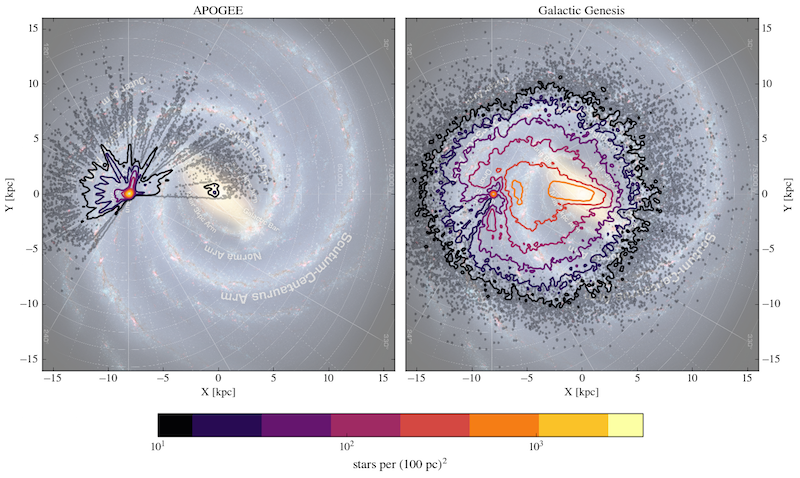Milky Way Mapper
The Milky Way Mapper (MWM) is a multi-object spectroscopic survey to obtain near-infrared and/or optical spectra of more than 4 million stars. These data, and the stellar parameters and elemental abundances derived from them, will enable a unique global Galactic map of the Milky Way’s fossil records that survive in its stars and interstellar material. The entire hierarchy of structure and chemo-dynamical patterns will be sampled throughout the disk- and bulge-dominated regions of the Milky Way. These data will allow us to quantitatively test models of the most uncertain galaxy formation physics (e.g., Rix & Bovy 2013; Bland-Hawthorn & Gerhard 2016).
MWM will make use of the BOSS and APOGEE spectrographs, taking advantage of their different spectral resolutions (R~2,000 and R~22,500) and wavelength sensitivities (3600-10,400 Å and 1.51–1.70 μm) to explore different types of stars.

Science Goals
The ecosystem of stars, gas, dust, and dark matter in large galaxies like the Milky Way has been shaped over billions of years by numerous physical processes that dominate on different spatial and temporal scales. MWM will take advantage of our unique perspective within our own Galaxy to create a uniquely high-resolution map of the Milky Way’s stellar characteristics. There are three primary sub-programs included in the MWM survey: Galactic Genesis, Stellar Astrophysics, and Stellar System Architecture.
The Galactic Genesis (GG) program will produce the first spectroscopic stellar map that is contiguously and densely sampled across the entire sky, with a focus on the low Galactic latitudes where most stars lie. This map will significantly expand the spectroscopic census of both young stars that trace the history of the Galaxy’s recent star formation, and of ancient stellar remnants that date back to the very young Milky Way. The stellar kinematics and chemical abundances derived for millions of red giant stars will provide tools for addressing questions such as Milky Way formation mechanisms, the impact of radial migration, and the place of the Milky Way in a cosmological context.
Both the Stellar Astrophysics (SA) and Stellar System Architecture (SSA) programs take advantage of the panoptic spectral capabilities of SDSS-V to measure mass, age, chemical composition, internal structure, rotation, and the presence of companions for vast samples of stars across the color-magnitude diagram. The SA program will include observations of giant stars with asteroseismic detections, massive main-sequence stars, white dwarfs, young stars in deeply embedded clusters, and a volume-limited sample of stars within 100 pc. The SSA program will target tens of thousands of multi-star and planetary systems in order to understand the factors governing the frequency and structure of multi-companion systems.
More details on the Milky Way Mapper and an extended description of its science goals can be found in the SDSS-V White Paper SDSS-V: Pioneering Panoptic Spectroscopy.

Contact information
For more information on the Milky Way Mapper, contact the SDSS-V/MWM Program Head, Jennifer Johnson (Ohio State University).


